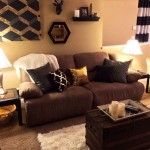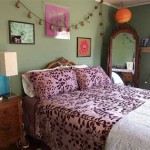How To Arrange And Decorate A Small Living Room
Arranging and decorating a small living room presents a unique set of challenges. Maximizing space, optimizing functionality, and creating an aesthetically pleasing environment require careful planning and thoughtful execution. Strategic furniture selection, clever storage solutions, and the judicious use of color and light are crucial for transforming a cramped area into a comfortable and inviting living space.
The primary goal in decorating a small living room is to create an illusion of spaciousness. This involves minimizing clutter, choosing furniture pieces that serve multiple purposes, and employing design techniques that visually expand the room. By approaching the project with a clear understanding of the space's limitations and potential, it is possible to create a living room that feels both stylish and functional.
Furniture Selection and Placement
Selecting the right furniture is paramount in a small living room. Large, bulky pieces can overwhelm the space and make it feel even smaller than it is. Opting for smaller-scale furniture and prioritizing multi-functional items is essential.
Consider a sofa with built-in storage. Many sofas now come equipped with drawers underneath or compartments within the armrests. These features provide valuable space for storing blankets, pillows, and other living room essentials, helping to keep the room tidy and organized. A sectional sofa with a chaise lounge can provide ample seating without taking up as much floor space as individual chairs.
Instead of a large coffee table, consider using a pair of smaller tables or an ottoman that can serve as both a coffee table and extra seating. Nesting tables are also a great option, as they can be easily pulled out when needed and tucked away when not in use. Select tables with open frameworks to allow light and visibility, creating a sense of airiness.
Placement of furniture is just as crucial as the selection itself. Avoid pushing all furniture against the walls, as this can actually make the room feel smaller and more boxy. Instead, experiment with arranging furniture at slight angles to create visual interest and define different zones within the room. Ensure that there is enough space to move freely around the furniture without bumping into anything.
Properly sizing the rug is also important. A rug that is too small will make the room feel disjointed, while a rug that is too large will overwhelm the space. Ideally, the rug should be large enough to anchor the main seating area, with the front legs of the sofa and chairs resting on the rug. This helps to visually connect the furniture and create a cohesive look.
Vertical space is often underutilized in small living rooms. Tall, narrow bookshelves or wall-mounted shelves can provide valuable storage without taking up valuable floor space. Utilize this vertical space to display books, decorative items, and plants, adding visual interest and personality to the room.
Consider clear or acrylic furniture pieces. These transparent items allow light to pass through, making the room feel more open and spacious. A clear coffee table or a set of acrylic chairs can be both stylish and functional in a small living room.
Color Palette and Lighting
The color palette plays a significant role in creating a sense of spaciousness in a small living room. Lighter, neutral colors tend to reflect more light, making the room feel brighter and more open. Darker colors, on the other hand, can absorb light and make the room feel smaller and more enclosed.
Opt for a light and airy color scheme for the walls, such as white, off-white, light gray, or pale blue. These colors will create a sense of openness and reflect natural light. To add visual interest, incorporate pops of color through accessories, artwork, and textiles. A colorful throw pillow or a vibrant piece of art can inject personality into the room without overwhelming the space.
Avoid using too many different colors in a small living room, as this can make the space feel cluttered and chaotic. Stick to a limited color palette, focusing on two or three main colors and using them consistently throughout the room. This will create a sense of harmony and coherence.
Proper lighting is essential for creating a welcoming and functional living space. In a small living room, it is especially important to maximize natural light. Keep windows clear and unobstructed to allow as much natural light as possible to enter the room. Avoid using heavy curtains or blinds that block out the light. Instead, opt for sheer curtains or blinds that allow light to filter through while still providing privacy.
Supplement natural light with artificial lighting to create a well-lit and inviting space. Use a combination of ambient, task, and accent lighting to create depth and dimension. Ambient lighting provides overall illumination, task lighting is used for specific activities such as reading or working, and accent lighting is used to highlight architectural features or decorative items.
A floor lamp can provide ambient lighting without taking up valuable table space. A table lamp on a side table can provide task lighting for reading or working. Wall-mounted sconces can provide accent lighting and add a touch of elegance to the room.
Mirrors can be used to reflect light and create the illusion of more space. Hang a large mirror on a wall opposite a window to reflect natural light and make the room feel brighter and more open. Mirrors can also be used to create depth and dimension by placing them strategically throughout the room.
Consider using light-colored flooring materials, such as light wood, tile, or laminate. These materials will reflect light and make the room feel brighter and more open. If you have dark flooring, consider using a light-colored rug to brighten up the space.
Storage Solutions and Organization
Effective storage solutions are crucial for keeping a small living room organized and clutter-free. Clutter can quickly overwhelm a small space and make it feel even smaller than it is. By implementing clever storage solutions, it is possible to keep the room tidy and maximize usable space.
Utilize vertical space by installing shelves above the sofa or above the television. These shelves can be used to store books, decorative items, and other living room essentials. Choose shelves that are shallow in depth to avoid taking up too much visual space.
Ottomans with storage are a great way to add extra seating and storage to a small living room. These ottomans can be used to store blankets, pillows, and other items that you want to keep out of sight. Choose an ottoman that complements the style of your furniture and adds a touch of elegance to the room.
Baskets and bins are a versatile storage solution for a small living room. These can be used to store magazines, toys, and other items that tend to accumulate in the living room. Choose baskets and bins that are made of natural materials, such as wicker or seagrass, to add texture and warmth to the room.
Wall-mounted cabinets are a great way to add storage without taking up valuable floor space. These cabinets can be used to store books, media equipment, and other items that you want to keep organized. Choose cabinets that are shallow in depth to avoid taking up too much visual space.
Consider repurposing existing furniture to create storage space. For example, an old trunk can be used as a coffee table and storage unit. A ladder can be used as a bookshelf. Get creative and think outside the box to find new uses for existing furniture.
Regularly declutter the living room to keep it organized and clutter-free. Get rid of items that you no longer need or use. Donate or sell items that are in good condition. This will help to create a more spacious and inviting living space.
Employ floating shelves to display curated collections. Strategically placed floating shelves provide a modern and minimalist storage solution while showcasing personal items without consuming floor space. Consider varying the shelf lengths and heights to add visual dynamism.
Introduce a console table behind the sofa. This creates a 'buffer' behind the sofa for visual separation. It serves as a surface for lamps, decorative items, and can be used to hide electrical cords neatly tucked away.

How To Arrange Furniture In A Small Living Room Setting For Four Interiors
:strip_icc()/cdn.cliqueinc.com__cache__posts__191613__small-living-room-ideas-191613-1526001981902-main.700x0c-ab3bbf79e5664b22b0a1973abcd3a11f.jpg?strip=all)
35 Designer Approved Small Living Room Ideas

10 Stunning Small Living Room Ideas To Maximize Space

How To Arrange Furniture In A Small Living Room Setting For Four Interiors
:strip_icc()/cdn.cliqueinc.com__cache__posts__261477__small-living-room-paint-colors-261477-1529967318143-image.700x0c-89d019d570e945f7a9ede0eb7bb5ff44.jpg?strip=all)
35 Designer Approved Small Living Room Ideas

Small Living Room Furniture Arrangement Ideas Design Cafe

How To Decorate A Small Living Room With Plants Plant Care Tips And More La Résidence

8 Decorating Ideas For Styling A Small Living Room Ruggable Blog
:strip_icc()/cdn.cliqueinc.com__cache__posts__277814__how-to-decorate-a-small-living-room-277814-1551117587765-main.700x0c-4309ac2c88e045309331c6a3488108f1.jpg?strip=all)
35 Designer Approved Small Living Room Ideas

50 Inspirational Living Room Ideas Design
Related Posts







